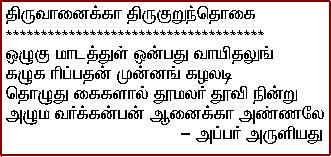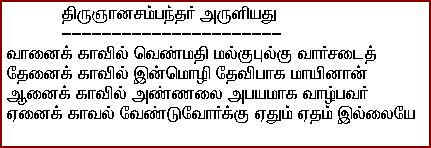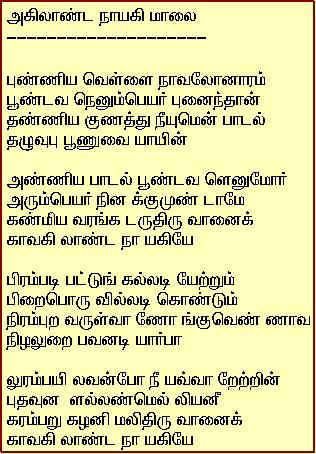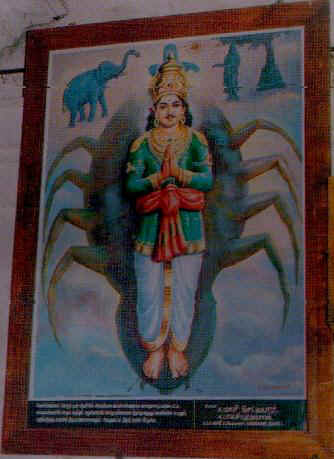
Legends/Facts
Thaadanga Pradhishtaa / Adhi Shankara
Once Goddess Akilandeswari was fierce like 'Ugra Devatha'. Sri Adhi Shankara transferred her ferocity into 'Thadangas'(ear rings) and the adorned her with the 'Thadangas'. He also installed 'Prasanna Vinayaga' (Lord Ganesh), opposite to her shrine so that She might look on with a beneficent eye. The Thadanga Pratishtha is done even today (once in few years) by the Sankaracharyars (successors of Adhi Shankara) of the Kanchi Kamakoti Pitham.
The Kanchi Kamakoti Peetam is also running a 'Vedha Padasala' (religious school where the Vedas are taught) on the North Car street at its Mutt.
Kalamega Pulavar
Once a learned Saivite started to penance to Akilandeswari to achieve wisdom in all arts. Devi Akilandeswari came before him in an ordinary women disguise wearing a white saree and asked him to open the saivites mouth to spit the petal leaves she was chewing. The saivite out of much dislike insulted Devi.
At that time 'Kalamegam' was sleeping within the temple premises, Devi Akilandeswari appeared before him and spat into his mouth the betel that she was munching. “Kalamegam” immediately obtained wisdom and went into poetic raptures. He became a very great Tamil poet then was called as “Kavi Kalamegam”. He then sung 'Thiruaanaika Ula' praising Devi Akilandeswari.
Kalamega Pulavar sung the 'Saraswathi Maalai' on Akilandeswari, envisaged her as Goddess Saraswathi (Goddess of Wisdom). One song from the 'Saraswathi Maalai' is..

Other Saints Visited this Temple
Many saints visited this temple and sung songs on Jambukeshwara and Akilandeswari. To name few are the four famous Nayannmars Appar, Sundarar, Thirugnansambandar (these four Nayannmars are also called as 'Saiva Naalvar') and the famous Muruga devotee Arunagirinathar and the legendary Carnatic composer Sri Muthuswamy Dikshithar, who is one among the 'Sangeetha Mummorthigal'.
Appar:
The saivite saint 'Thirunavukarasar' who is also popularly known as 'Appar' sung 'Thiruvanaikaa Thirukkurunthogai' to praise the Lord and Devi of Thiruvanaikoil. One such song, which explains the way how to pray the Lord at Thiruvanaikoil is..

Sundarar:
Sundarar sung songs mentioning the Lord at Thiruvanaikoil is the form of the four 'Vedhas'.
Thiru Gnanasambandar (Sambandar):
The child prodigy and one of the famous 'Nayannmar' Thirugnasambandar sung many songs ('Padhigam') praising the Lord and Devi of Thiruvanaikoil. One such is..

Arunagirinathar:
Arunagirinathar sung many songs in his master piece 'Thirupugazh'(Thirupugazh was sung in praise of Lord Muruga). One such song is..

This song tells the story of the construction of 'Thiruneetran Madhil' i.e. the 'Vibhoothi Praharam'.
MeenakshiSundaram Pillai:
'Mahavithvan' Thirusirapuram (Olden days name of Trichy) MeenakshiSundaram Pillai has written 'Thiruvaanaikaa Akilandanayaki Maalai'. praising Devi Akilandeswari and Lord Jambulinga of Thiruvanaikoil. An example from his extraordinary poetic work is...

Kachchiyappa Munivar:
Kacchiyappa Munivar lived in late 18th Century. He was also known as 'KaviRatchasan'. He was one of the 'Adhinams' (Saint) of 'Thiruvavaduthurai Mutt'. Kachchiyappa Munivar is the one to come up with the history of the Thiruvanaikoil temple through his master piece 'Thiruvanaika Puranam'.
Muthuswamy Dikshithar:
This shrine has been immortalised by one of the Trinity of Carnatic music Muthuswami Dikshitar, with two unusual compositions in Sanskrit, one titled ‘Jambupate’ in 'Yamunakalyani' 'Raga' and the other ‘Akilandeswari’ in 'Dvijavanti' raga. Both compositions are in ragas that are not indigenous to the south but borrowed from the music of the north (resembling Hindustani music).
The Dikshitar song, however, is a masterpiece of classical Carnatic traditions, layered, slow and restrained, and yet magnificent and joyous; an outpouring to Shiva in His manifestation as water, "Ambudhi Ganga Cauvery Yamuna kambu-kantya Akhilandeswari ramana", Lord of the oceans, and of the Ganga, Cauvery and Yamuna, and of Akhilandeswari, She of the throat as smooth as a conch . . .
Ko Chengot Chola:
King Ko Chengot Chola (Ko Chenkkannan) is the spider, which worshiped the Lord Shiva. He was born to King Subhadeva and Queen Kamalavati. There is a legend behind the name of Chenkannan. As the King Subhadeva had no male successor to rule his kingdom, he worshipped to Lord Shiva with the queen. Later the queen conceived and before Chenkannans birth the astrologer specified the queen a time for the birth for the child and also told her that if she gives birth at that time then the kid will bring fame to the Chola dynasty. But the Queen thought that she might give birth earlier than the time specified by the astrologer. As the Queen was so keen on the hour of birth she asked her maids to tie her legs and hang her upside down to delay the birth of the child. Then she gave birth to the child in the right time. As the child stayed more time on mother’s womb, the child born with reddened eyes. So he is name as Chenkannan meaning Chen – Red, Kannan – Eyed.

This painting of Ko Chengot Chola is installed at the Swami temple. This painting reminds us the earlier birth of the King (as a spider), which worshipped Lord of Thiruvanaikoil
A small separate 'sannadhi' (Sanctorum) was built to Ko Chengot Chola in 1980’s at the Swami temple (near the “Urchava Moorthy” mandapam), where his idol has been installed and worshipped.